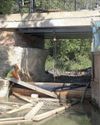The canal-builders usually went in for practical, unpretentious construction, but just occasionally there was a call for something different…

The waterway widens out and makes a sharp right turn, passing under an attractive broad arched footbridge before making a sweeping bend to the left. Ahead, a stately three-arch white painted bridge spans the water, which meanders to the left in the distance…
A description of a river in the Home Counties, perhaps? Or an ornamental lake in a country estate? No, this is actually a length of that former freight carrying artery and backbone of southern England’s waterways, the Grand Union Canal. So why is it doing a passable imitation of a river? It’s all down to that bane of the canal builders’ lives – the landowners.
Crossing hills and valleys may have brought engineering challenges, but dealing with those whose land the new canal crossed could be equally tricky – especially if they were rich and influential. Sure, many of the landed gentry (including the most famous in canal circles, the Duke of Bridgewater) were also investors in canal-building and owners of local industries who stood to benefit from the trade and profits the canal would bring. But there were plenty more for whom it was an unwelcome intrusion, spoiling their view and threatening to destroy their peace with the arrival of the working boatmen and – worse still – the navvies who built it.
Almost all canals were built using an Act of Parliament – which gave the company powers of compulsory purchase to acquire land for the route. But to get the Act, the canal’s promoters had to gain parliamentary approval. In theory this meant successfully arguing the case on the basis of the great benefits that the new waterway would bring to the country that it served; in practice it could be more about buying off opposition from supporters of rival canals and others who might be affected – including wealthy landowners.
Diese Geschichte stammt aus der March 2017-Ausgabe von Canal Boat.
Starten Sie Ihre 7-tägige kostenlose Testversion von Magzter GOLD, um auf Tausende kuratierte Premium-Storys sowie über 8.000 Zeitschriften und Zeitungen zuzugreifen.
Bereits Abonnent ? Anmelden
Diese Geschichte stammt aus der March 2017-Ausgabe von Canal Boat.
Starten Sie Ihre 7-tägige kostenlose Testversion von Magzter GOLD, um auf Tausende kuratierte Premium-Storys sowie über 8.000 Zeitschriften und Zeitungen zuzugreifen.
Bereits Abonnent? Anmelden

HIGH AND MIGHTY
Acorns make the perfect store food for jays’ larders

TAKING THE PLUNGE
Why Chris and Sarah Atkin will never forget tying the knot

LABELLED WITH LOVE
Helen Tidy enjoyed one weekend moored next to The Beer Boat ... simply the perfect solution to collecting bottle tops for her next project

MIDDLE THAMES
In the second part of our guide, we follow the Thames upstream from Reading through the steep sided Goring Gap and quieter countryide to reach Oxford

THE GOOD OLD DAYS
Robert Davies recalls childhood memories of a popular holiday destination and uncovers a reminder of the golden age of canals

FIT FOR PURPOSE
Terry Hibbard from Harworth Heating offers his expert opinion following our feature on onboard stove safety

BUCKING UP...
We join Waterway Recovery Group’s first canal restoration working party in six months - as WRG’s volunteers help the Buckingham Canal Society get the project back on track after lockdown

ART ON THE WATER
Graphic artist Katie Ruby lives and works on 32ft narrowboat Poppy
GO WITH THE FLOW
What makes a boat truly stand out from the crowd? Sometimes you just need a little finesse and a taste for adventure
A GLASS HALF-FULL AT BUCKBY WHARF
Tim Coghlan raised a glass on the Grand Union Canal as The New Inn reopened to the relief of regulars